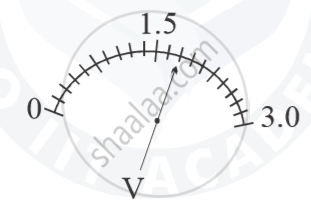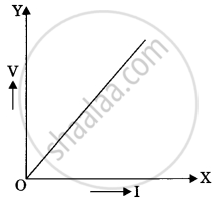Advertisements
Advertisements
Question
Consider the sacle of voltmeter shown in the diagram and answer the following questions :

(a) What is the least count of the voltmeter?
(b) What is the reading shown by the voltmeter ?
(c) If the voltmeter is connected across a resistor of 20 `Omega` how much current is flowing through the resistor?
Solution
(a) Least count = `3/20 = 0.15V`
(b) `(1.5 + 0.15 + 0.15)V = 1.8 V`
(c) R = 20 `Omega`
`V = 1.8 V`
`therefore I = ?`
By ohm’s law
`V = IR`
`1.8/20 = I therefore I = 0.09 A`
APPEARS IN
RELATED QUESTIONS
If the potential difference across the ends of a conductor is 220 V and the resistance of the conductor is 44 Ω (ohm), then the current flowing through is _________.
- 0.2 A
- 0.5 A
- 2 A
- 5 A
Will current flow more easily through a thick wire or a thin wire of the same material, when connected to the same source? Why?
The relationship between the potential difference and the current in a conductor is stated in the form of a law.
1) Name the law.
2) What does the slope of V-I graph for a conductor represent?
3) Name the material used for making the connecting wire.
Name the unit of electrical resistance and give its symbol.
The graph between V and I for a conductor is a straight line passing through the origin.
What should remain constant in a statement of this law?
Draw a neat diagram for the verification of Ohm’s law by voltmeter-ammeter method. By another diagram show the relation between p.d. and current.
Choose the correct alternative.
Which of the following is an ohmic conductor?
Define temperature coefficient of resistance.
The slope of voltage (V) versus current (I) is called:

Consider a current carrying wire (current I) in the shape of a circle. Note that as the current progresses along the wire, the direction of j (current density) changes in an exact manner, while the current I remain unaffected. The agent that is essentially responsible for is ______.
